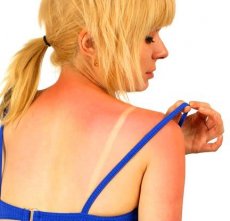Medical expert of the article
New publications
Biologists have discovered why skin turns red and itchy when sunburned
Last reviewed: 01.07.2025

All iLive content is medically reviewed or fact checked to ensure as much factual accuracy as possible.
We have strict sourcing guidelines and only link to reputable media sites, academic research institutions and, whenever possible, medically peer reviewed studies. Note that the numbers in parentheses ([1], [2], etc.) are clickable links to these studies.
If you feel that any of our content is inaccurate, out-of-date, or otherwise questionable, please select it and press Ctrl + Enter.

Damaged skin cells from sunburn release large amounts of deformed signaling RNA molecules that invade healthy cells and cause them to produce proteins that cause inflammation and other characteristic signs of over-tanning - redness and tenderness, scientists say in an article published in the journal Nature Medicine.
"Some diseases, in particular psoriasis, are treated with ultraviolet radiation. The main problem with this therapy is the increased likelihood of developing skin cancer. Thanks to our discovery, we can obtain the positive effects of UV radiation without the radiation itself. In addition, we can now block this mechanism to protect the body of particularly sensitive people, for example, lupus patients, from ultraviolet radiation," said Richard Gallo, the head of the biologist group from the University of California in San Diego (USA).
Gallo and his colleagues studied the effects of ultraviolet radiation exposure on human skin cultures and on the skin of healthy mice.
In the first experiment, biologists grew several skin cell cultures, divided them into two groups, and irradiated half of them with ultraviolet light for a minute. The intensity of this radiation simulates a severe sunburn, causing some of the cells in the test tubes to either die or become irreversibly damaged. After some time, the scientists cleared the nutrient medium of cells and added it to test tubes with healthy cultures.
This led to unusual consequences - healthy cells began to secrete large quantities of TNF-alpha and interleukin-6 protein molecules. These compounds belong to the class of anti-inflammatory proteins that stimulate metabolism, put healthy cells into "emergency" mode and trigger self-destruction mechanisms in damaged cells.
The biologists analyzed the contents of the extract from the nutrient medium in which the irradiated cells lived and found many deformed molecules of signal RNA. According to Gallo and his colleagues, these molecules were connected to special protein outgrowths on the walls of healthy cells - receptors of the innate immune system TLR-3. This receptor belongs to a class of so-called Toll-like receptors, which control the protective reaction to some types of bacteria and the appearance of cancer cells.
Scientists synthesized artificial RNA molecules similar to those produced by healthy cells and irradiated them with ultraviolet light. They added the resulting molecules to the nutrient medium of healthy cells and monitored their reaction. Synthetic RNAs produced the same effect as their natural counterparts.
In a subsequent experiment, Gallo and his colleagues counteracted this effect by deleting the TLR-3 receptor gene from the mice's genome. According to the scientists, disabling this gene made the rodents' skin insensitive to ultraviolet light and injections of damaged RNA - there was no redness of the skin, since healthy cells stopped secreting anti-inflammatory proteins.
As biologists note, drugs based on RNA molecules can be used as a “replacement” for radiation in some types of therapy.


 [
[